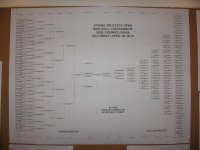64 Bracket
I got my 64 player, modified double elimination bracket today. In looking at it, I realized that, to my shock, you could play in the winner’s side final and end tied for 4th place. I didn’t like the idea of that. A person was always guaranteed 3rd if they got that far. I chewed on that for awhile, looked at the positives for his bracket and decided that I liked his thinking.
In fact, it got me thinking about many of different aspects that are “standard” in the pool world. Maybe we should step back, like Paul, and take a different view of those standards.
Suggestion: Maybe you don't need to start with the standard DE playing chart of 8, 16, 32, 64, 128, 256. The starting number could be based on the heart of your changes?
Good work Paul. I am anxious to see the other brackets to accomodate other amounts of players.
Thank you Paul.

